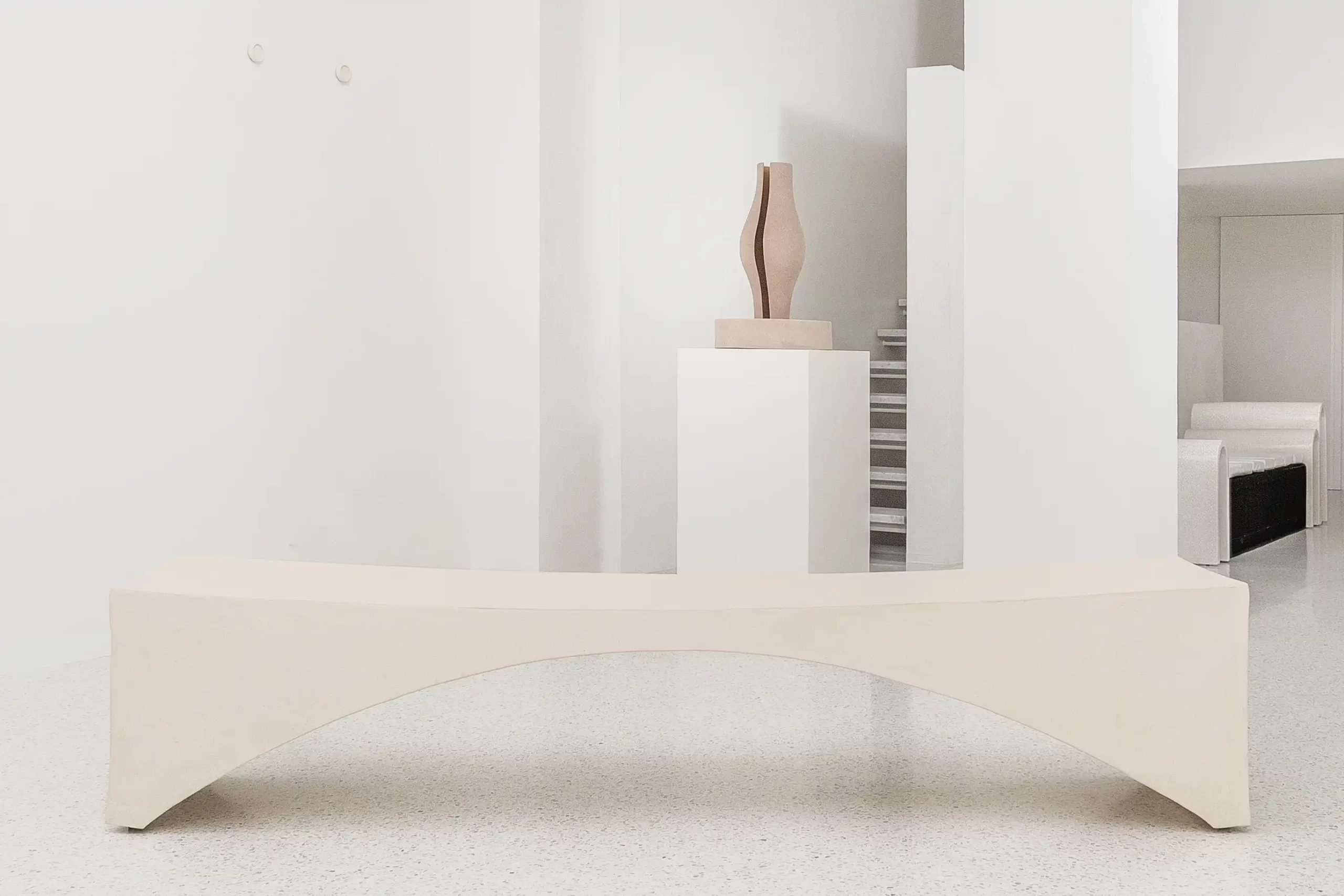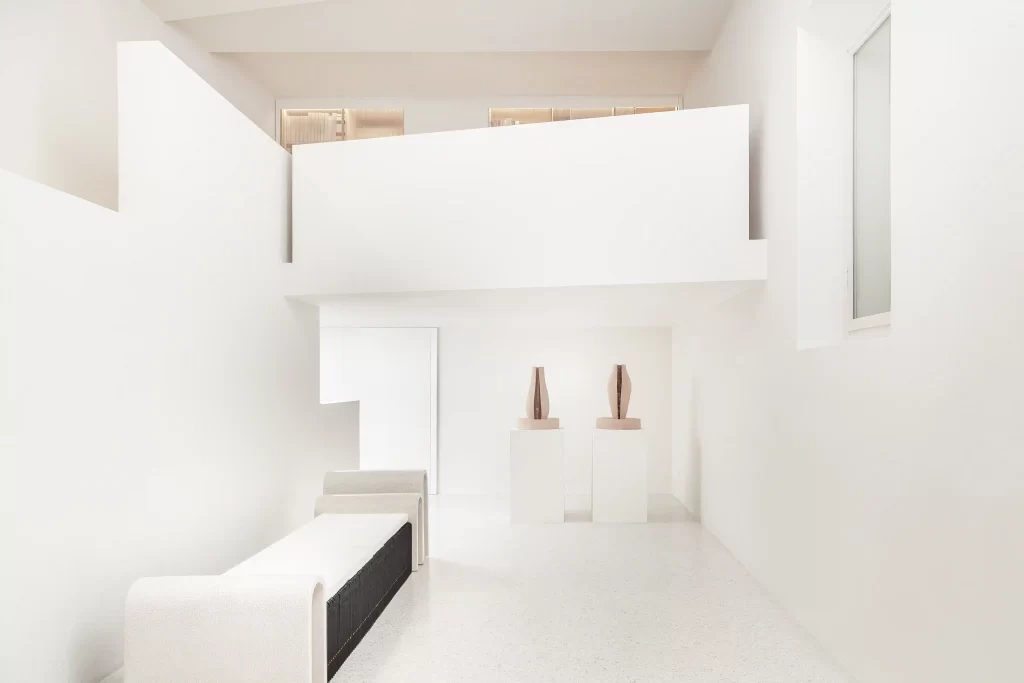Proporzione Mediterranea – a post-modern translation from the Amalfitan vaulted houses’ architecture to ceramic seating and vases
Architetti Artigiani Anonimi
Architetti Artigiani Anonimi is a design studio, based in Milan, founded by the architect Annarita Aversa in 2013. This group of people aims to celebrate spontaneous and authentic expressions of living. They want to work on architecture’s different scales, processing and synthesizing the variety of the temporal, cultural and architectural context. All of this, while supporting and promoting the identity of each place.
Architetti (architects) because they are defenders, cultivators and ambassadors. They maintain the authenticity of each space by unifying craftsmanship with cultural context rooted in tradition. They are the main components of the studio. The word Artigiani (craftsmen) is tied to the group’s modus operandi. Not only because of the collaborations they have with artisans, but the designing process is artisanal. It refers to certain people, places and time, therefore, every time these variables change, so do the results. In this way, Architetti Artigiani Anonimi’s studio becomes less self-referential, but an interpreter of different realities. Consequently they create unrecognizable results, here comes the term ‘Anonimi’ (anonymous). Annarita clarifies: «we do not want to deliver branded results that are identical to preset codes and languages».
Proporzione Mediterranea: a post-modern ode to vernacular architecture
From September until October, 2022, ‘Proporzione Mediterranea’, was exhibited at Giustini / Stagetti gallery in Rome. It is a limited-edition collection of seating and vases inspired by the visual and sensorial force of vernacular Mediterranean houses and designed by architect Annarita Aversa.
Through this collection, Aversa returned to the origins and the essence of architecture. She rediscovered the intimate and truthful connection between man and inhabited space, driven by proportions, needs, desires and abilities.
What brought Annarita to realize this project was the awareness that she developed. This after her foreign experiences, on the excess, the individualism that characterizes today’s world that brought architecture to be deviated from its original purpose.
The collection, refers to a spontaneous form of architecture. «I’ve always researched and appreciated ‘man’s architecture’. From ancient times to today. I wanted to understand the reasons that encourage man to create a space that has function and shape».
Proporzione Mediterranea takes inspiration from the Amalfi coast, Annarita’s hometown. A place famous for the vaulted-ceilings houses which represent a constant element throughout the project. Originated from farmers and a spontaneous relationship among mind, space, necessity and construction, Amalfitan Vernacular architecture embodies authenticity. Therefore, the values that Architetti Artigiani Anonimi’s studio believes in.
The Sixties: when the architect also designed the furniture
What Aversa did was a transposition of the still Mediterranean Vernacular architecture in a mobile one. She distinguished still architecture from mobile architecture, considering that design and architecture are conceived as the same concept for Annarita.
One of Vernacular architecture’s main values is that the modelling of the space happens in conjunction with the modelling of the furnishings. «This aspect underlines that the architecture, the space, and everything within it, represent a unique set. They manage to balance the context. These elements should be conceived as a unicum as it happened untill the sixties. This is when the architect also designed the furniture. They did this in order for the spaces to be well-balanced and respect their main concept» explains Aversa.
Gesamtkunstwerk: merge the world of architecture and design
The limited-edition collection includes a daybed, a sofa, a bench and a selection of vases and as an integral part of the architectural Gesamtkunstwerk, the pieces create a natural play of light and shadow underlining Aversa’s intent to merge the world of architecture and design. Every object’s detail recalls the purpose of the project that is to remind architects of the reasons behind their precise task in an era often contaminated with disorienting images.
Proporzione Mediterranea’s materials – a tale of artisans and traditions
Ceramic and iron were used in the making of Proporzione Mediterranea’s pieces. Ceramic was the only material able to recreate the masonry concept in a mobile object. It is strictly tied to Amalfitan coast’s traditions. Vietri sul mare, a town on the coast, is known for its long time tradition of making pottery. That is where Proporzione Mediterranea’s pieces have been produced.
For the daybed, Aversa reused techniques and polishes of Vietri sul mare. They were linked to research from the fifties by an American designer. Therefore, she found a way to revive, in a contemporary key, traditional and past research.
Iron was a crafted material in Amalfi, especially during the Maritime Republic when several ironworks were established to make weapons.
Mediterranean vernacular: sustainable architecture
Overall, this collection can be considered as a sustainable project. This is due to the connection to artisanal traditions and the approach to sustainable architecture.
Mediterranean vernacular architecture represents an example of sustainable architecture. All the materials were locally sourced and everything was constructed respecting man’s and nature’s needs, as an expression of the synthesis of the man that designs, builds and inhabits; «only by mixing up these three experiences and abilities, people are able to develop balanced thoughts on what is correct and convenient in bioclimatic, sustainable, economical and constructive terms» Aversa points out.
Mobile vernacular architecture – a rhythm of solids and voids
Every piece of the collection presents a particular rhythm of solids and voids, a proportion typical of this form of architecture that comes from a direct relationship between man and objects, which is further enhanced by the rawness of the materials.
In some pieces, the proportion of light that enters the space, through small surface ribs, presents both an aesthetic value and a functional one, due to the look it gives and the irradiation it undergoes.
The whole project re-interpret this idea of proportion, just as it happens with the vases, which are not proper vases but they are prototypes of an ideal architecture. Their ‘skin’ opens in a balanced mix of space, light, and water, defining a safe place for the inhabitant from which to observe the world, in fact, the design echoes the intimacy of vaulted spaces and more explicitly the womb, humans first home.
The modular seating pieces, on the other hand, create a balance of technique and form as a natural extension of space, recalling to benches set along the edges of coastal terraces, challenging the boundary between architecture and landscape.
Rhythmed volumes, sinuous geometries and a game of light and shadows
In general, the architecture that characterizes the coast’s landscape resembles an osmotic way of inhabiting: the subtle boundaries between in and out are traced in order to keep the limits permeable, letting domestic life to flow from the inside to the outside, and viceversa.
Similarly, the furnishing preserves this porous state through rhythmed volumes, sinuous geometries and a game of light and shadows. Therefore, the intent of the architect is to reconnect design’s and architecture’s world, considering them as the result of the same creative process, with one idea of space, light and material, true expression of a precise moment, place and culture.
Italian origins – between roots and rediscovery
Architect Annarita Aversa defines her feelings for her hometown, Amalfi coast, and Italy in general, as a relationship made of roots and rediscovery. Aversa grew up through a foreign-oriented education until her late teens, but after the first job experiences abroad, she rediscovered and properly understood the cultural and the artistic roots of her country.
«The challenge was to be able of being an ambassador of my culture, but also to find a way to preserve it, so that, I’ve started working focusing on cultural responsibility and on everything that can happen inside my country’s context rather than foreign ones» explains Aversa.
From that moment she started managing to understand how to intervene in the Italian territory, trying to dialogue with a complex and context from both a historical and architectural point of view. «My return to Italy has favored the love story I now have with my country, its culture and everything it has to offer. Therefore, as an Italian I try, in my small way, to feel a certain responsibility in everything I do and in what architects are called upon to do, today» states Aversa.
Proporzione Mediterranea by Annarita Aversa
The founder of Architetti Artigiani Anonimi, architect Annarita Aversa, has introduced ‘Proporzione Mediterranea’. It is a collection of seating and vases inspired by the vaulted houses of the Amalfi coast, her hometown. The collection, that was displayed this year from September to October at Giustini / Stagetti gallery in Rome, was built on the architect’s ethos of the idea of space, light and material by fusing design and architecture. Proporzione Mediterranea is a memento of vernacular architecture. It is a heritage preservation that keeps narrating its worth and value again and again.




















